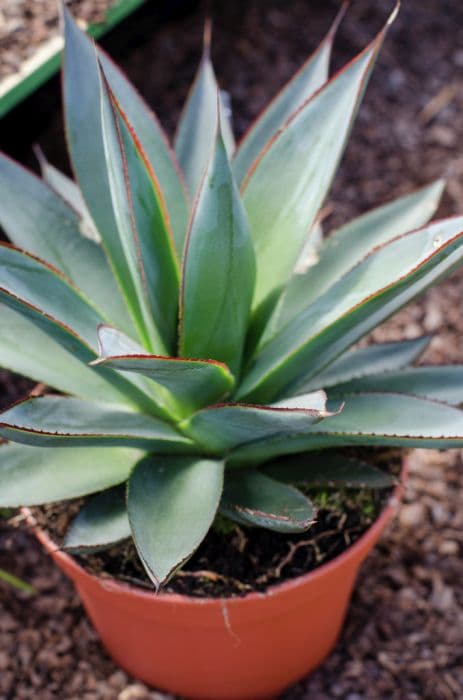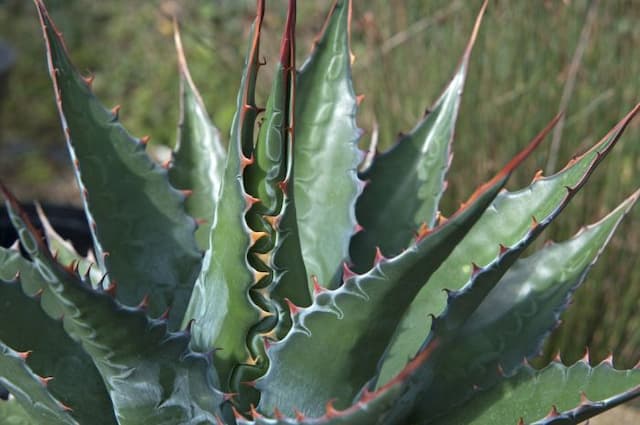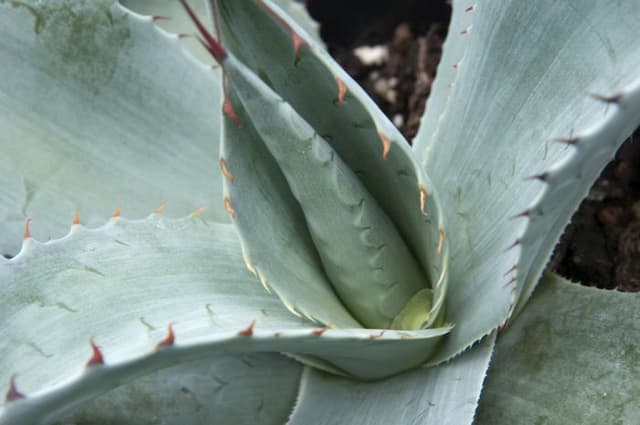Cabbage Head Agave Agave parrasana

ABOUT
Agave parrasana, commonly known as Cabbage Head Agave due to its rosette form that resembles the head of a cabbage, has a distinct and attractive appearance. This plant showcases a dense cluster of fleshy, spoon-shaped leaves. Each leaf typically has a powdery blue or glaucous gray-green color, contributing to its unique palette. The leaves exhibit a striking pattern as they arch gracefully from the center of the rosette, their tips tending to point upwards creating a somewhat spherical form. The texture of the leaves is rigid and tough, with a leathery quality that is well-adapted for arid environments. Along the edges of each leaf, you'll often find small teeth-like structures which add to its ornamental appeal. Furthermore, the end of each leaf often culminates in a sharp point or terminal spine which can be quite pronounced and gives the plant a slightly formidable appearance. In maturity and the right conditions, this agave may produce a tall flower spike which stands in stark contrast to the compact rosette below. However, the details of this flowering process are beyond the designated scope of appearance for this description.
About this plant
 Names
NamesSynonyms
Cabbage Head Agave, Parras Agave
Common names
Agave parrasana.
 Toxicity
ToxicityTo humans
The Cabbage Head Agave, also known as Agave parrasana, is not commonly known for being significantly poisonous to humans. However, like many agave species, it has sharp spines that can cause physical injury if not handled with care. Ingesting parts of this plant is not typically associated with severe toxicity, but it might cause gastrointestinal irritation if consumed in large quantities. Symptoms may include nausea, vomiting, and diarrhea. Moreover, the sap of agave plants can be irritating to the skin and mucous membranes, potentially causing dermatitis or allergic reactions in sensitive individuals.
To pets
The Cabbage Head Agave, or Agave parrasana, is similar in toxicity to pets as it is to humans. It is not recognized as a plant with high toxicity levels. Nevertheless, if pets chew on or ingest parts of this plant, they could experience mild gastrointestinal upset. Symptoms might include vomiting or diarrhea, due to the plant's fibrous nature and potential irritants. As with humans, the physical structure of the plant, predominantly its spines, pose a risk for physical injury. Additionally, the sap may cause irritation or allergic reactions for pets, particularly for those with sensitive skin or predisposition to allergies.
 Characteristics
CharacteristicsLife cycle
Perennials
Foliage type
Evergreen
Color of leaves
Blue-green
Flower color
Yellow
Height
2-3 feet [60-90 cm]
Spread
2-3 feet [60-90 cm]
Plant type
Succulent
Hardiness zones
8
Native area
Mexico
Benefits
 General Benefits
General Benefits- Drought Tolerance: Agave parrasana, also known as Cabbage Head Agave, requires minimal water once established, making it an excellent plant for xeriscaping and dry garden landscapes.
- Low Maintenance: This succulent is easy to care for, needing only occasional maintenance, which is ideal for gardeners looking for low-effort plants.
- Ornamental Appeal: With its rosette of thick, blue-green leaves edged with teeth, the Cabbage Head Agave provides a striking visual interest in gardens, rockeries, and as a patio plant.
- Longevity: Agave parrasana is known for its longevity, often living for many years and providing a consistent aesthetic appeal throughout its life.
- Deterrent Features: The spiny edges and pointed tips of the leaves can serve as a natural barrier, deterring unwelcome animals from entering garden areas.
- Soil Erosion Control: Its root system helps stabilize soil, making it an excellent option for slopes or areas prone to erosion.
- Architectural Landscaping: Cabbage Head Agave is commonly used in architectural landscaping due to its sculptural qualities that complement modern and contemporary design styles.
 Medical Properties
Medical PropertiesThis plant is not used for medical purposes.
 Air-purifying Qualities
Air-purifying QualitiesThis plant is not specifically known for air purifying qualities.
 Other Uses
Other Uses- Landscape Design: Agave parrasana, also known as Cabbage Head Agave, is often used in xeriscaping and drought-resistant landscapes due to its low water requirements and striking appearance.
- Production of Fibers: Similar to other agave species, fibers can be extracted from the leaves of the Cabbage Head Agave to create ropes, mats, and textiles.
- Ornamental Use: With its rosette pattern and blue-green leaves, it is a popular choice as a decorative plant in rock gardens and as a focal point in container gardens.
- Soil Erosion Control: Because of its extensive root system, Cabbage Head Agave can help stabilize soil and prevent erosion on slopes.
- Biological Pesticides: The plant's natural compounds may be used to develop less harmful pesticides that deter certain plant-eating pests.
- Water Harvesting: With its broad leaves, the Cabbage Head Agave can be strategically planted to aid in the collection and funnelling of rainwater to nearby plants needing hydration.
- Food Source for Wildlife: The plant's flowers can provide nectar for bees, butterflies, and hummingbirds, supporting biodiversity.
- Art and Craft: Its striking form and structure make Cabbage Head Agave an interesting subject for botanical drawing and other forms of art.
- Photography: The unique shape and color of the Cabbage Head Agave make it a popular subject for plant photographers, particularly in natural sunlight.
- Theme Gardens: The Cabbage Head Agave can be featured in Mexican or desert-themed gardens for education and cultural representation.
Interesting Facts
 Feng Shui
Feng ShuiThe plant Cabbage Head Agave is not used in Feng Shui practice.
 Zodiac Sign Compitability
Zodiac Sign CompitabilityThe plant Cabbage Head Agave is not used in astrology practice.
 Plant Symbolism
Plant Symbolism- Resilience: The Cabbage Head Agave is known for its ability to thrive in harsh, rocky environments, symbolizing resilience and the ability to endure challenging circumstances.
- Adaptability: As a plant that can adapt to extreme conditions, the Cabbage Head Agave represents flexibility and the capacity to adjust to changing situations.
- Conservation: Due to its low water requirements, the Cabbage Head Agave exemplifies conservation and the efficient use of resources.
- Longevity: Cabbage Head Agaves have a long lifecycle, often taking years to flower, which symbolizes patience and the concept of long-term growth and rewards.
- Self-reliance: The Cabbage Head Agave's ability to store water reflects self-sufficiency and the importance of preparing for future needs.
 Water
WaterThe Cabbage Head Agave should be watered sparingly, as it is drought-tolerant and adapted to arid conditions. It’s best to allow the soil to dry out completely before watering again. During the growing season, which is spring and summer, you might water it every two weeks, providing about 1-2 gallons depending on the size of the plant and the dryness of the soil. In the winter months, reduce watering to once a month or less. Overwatering can lead to root rot, so ensure proper drainage and err on the side of underwatering.
 Light
LightCabbage Head Agave thrives in full sun to partial shade. It should be planted or positioned in a location where it can receive direct sunlight for at least 6 hours a day. If grown indoors, a south-facing window is ideal to provide the bright light this agave needs. Be cautious of too much intense afternoon sun which can scorch the leaves, especially in hotter climates.
 Temperature
TemperatureCabbage Head Agave prefers temperatures between 50°F and 80°F but can tolerate a range down to freezing, though it should be protected from sustained periods of cold below 30°F. This plant is not frost-tolerant, and exposure to temperatures below its minimum range can damage or kill it. It enjoys warmth and will thrive in the ideal temperature range throughout most of the year in temperate regions.
 Pruning
PruningPruning the Cabbage Head Agave is primarily for removing old or damaged leaves and is not regularly required. The best time for pruning is in the spring or early summer when the plant is actively growing. Use clean, sharp tools to make cuts close to the base without harming the central rosette. Pruning is done as needed and might only be necessary every few years.
 Cleaning
CleaningAs needed
 Soil
SoilThe best soil mix for Cabbagehead Agave (Agave parrasana) is a well-draining mix, like a cactus or succulent potting mix, with added perlite or coarse sand for improved aeration. This plant prefers a slightly acidic to neutral pH of about 6.0 to 7.5 for optimal growth.
 Repotting
RepottingCabbagehead Agave (Agave parrasana) typically does not require frequent repotting. It should be repotted once every 3 to 4 years or when it outgrows its current pot, ensuring that the new pot allows room for growth.
 Humidity & Misting
Humidity & MistingCabbagehead Agave (Agave parrasana) is well adapted to dry, low humidity environments and does not require high humidity levels. Average room humidity is generally sufficient for this plant.
 Suitable locations
Suitable locationsIndoor
Place in bright light, minimal water.
Outdoor
Full sun, well-drained soil, little water.
Hardiness zone
8-10 USDA
 Life cycle
Life cycleAgave parrasana, commonly known as the Cabbage Head Agave, begins its life cycle as a seed, which germinates in well-draining soil under favorable warm conditions. The seedlings grow into rosette-shaped plants with thick, fleshy leaves adapted for water storage, which is crucial for survival in arid environments. The plant slowly matures over several years, during which it stores energy in preparation for its singular reproductive event. Once mature, typically after a decade or longer, the Cabbage Head Agave sends up a tall flower stalk that can reach several meters in height, displaying a spectacular array of flowers that attract pollinators such as bats, bees, and birds. After flowering, the plant usually sets seed and then, as is typical for most agaves, the parent plant dies, completing its monocarpic life cycle. The seeds then disperse to give rise to new plants, thereby continuing the species' cycle of life.
 Propogation
PropogationPropogation time
Spring-Early Summer
Agave parrasana, also known as Cabbage Head Agave, is typically propagated through the harvesting and planting of its "pups," or offsets. These are small clones of the parent plant that form around its base. The best time to propagate this plant is during the late spring or early summer when the weather begins to warm, which encourages active growth. To propagate by pups, carefully excavate around the base of the mature Cabbage Head Agave to expose the young plants. Using a sharp, clean knife or spade, sever the connection between the pup and the parent plant, making sure that each pup has some root material attached. After removing them, allow the pups to dry and callous over for a couple of days to prevent rotting when planted. Then, plant the pups in well-draining soil, watering them sparingly until they show signs of new growth, which indicates that they have established their roots.









